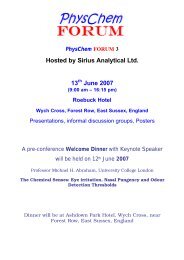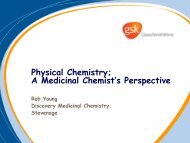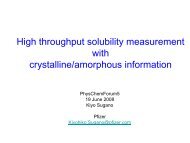PhysChem Measurements -more than just a ... - PhysChem Forum
PhysChem Measurements -more than just a ... - PhysChem Forum
PhysChem Measurements -more than just a ... - PhysChem Forum
You also want an ePaper? Increase the reach of your titles
YUMPU automatically turns print PDFs into web optimized ePapers that Google loves.
<strong>PhysChem</strong> <strong>Measurements</strong>-<strong>more</strong> <strong>than</strong> <strong>just</strong> a numberEmily FreemanPhysical and Analytical Sciences UCB<strong>PhysChem</strong> <strong>Forum</strong> June 2007
Overview<strong>PhysChem</strong> ReportOverview of the Assays run at UCBMore to learn from AKAS and HTLogDSummaryQuestions?
<strong>PhysChem</strong> ReportND Poor Modest GoodAKAS ND 350mMPSA >113 83-113
AKAS Automated Kinetic Aqueous SolubilityAll NCE’s10mM DMSO Stock SolutionKineticAqueous BufferFastest form to dissolve notnecessarily the most stableHT MultiPROBE II44 x compounds in 4hrsRun twice a weekFinal DMSO content 5%
AKAS at 4 pH’sRun at 4 pH’s to mimicthe varying pH range ofthe GI tract:pH3, pH5, pH7.4, pH9.Stomach pH 1 - 3Duodenum pH 5 – 7Blood pH7.4Colon pH 7 – 8Picture modified from: Alex Avdeef. Absorption andDrug Development Solubility, Permeability and ChargeState. pION, Inc. John Wiley & Sons 2003
Solubility Assays1 st Tier Solubility2 nd Tier SolubilityAKASPasses at>150uMQuickSolKinetic - from DMSO StockPseoudothermodynamic - from solid
Solubility Assays - QuickSolpH7.4 (pH5 on request)BufferPseudo-thermodynamicshaken for 90 minsSolid SampleStarts from solid butnot in excess.Analysis by HPLCDissolution may not becomplete in 90 mins.Only a single time point notnecessarily at the equilibrium.
Why is QSol Important?Crystal forms can have different solubilityDepending on the dissolution energy of the crystal latticeBatches can havedifferent crystal formsBatch to Batch VariationDo not Average BatchesNo DMSO present so no co-solvent effects - AKAS has 5% DMSO
Use the Right Assay for your QuestionA BiologistDMPKAssays startfrom DMSO Stock= AKASUsing Solidto dose animals= QSol
LipophilicityDistribution Around The BodyBloodAqueousTissuesLipophilicHTLogD 7.4 assaySample added to octanol and waterand shaken for 90 minutesPartitionOctanolWaterD(o/w)=[ionised][ionised]octaq+ [neutral]+ [neutral]octaqLayers are separated and analysedby HPLC
Why we measure LogD 7.4 not LogPLogPP= Partition coefficientLogD 7.4D = Distribution coefficientOctanol Neutral speciesWater Neutral speciesRatioOctanol Neutral and Ionised speciesWater Neutral and Ionised speciesLogP can only be run at a pH whereall of the compound is neutralLogD 7.4 can be run at thesame pH for all compoundsWould have to be run at adifferent pH for each compounddepending on it’s pKaIt’s run at a pH of interesteg pH7.4 for blood
Shake flask LogD 7.4vs HTLogD 7.45R 2 = 0.944HTLogD7.43210-2.5 -1.5 -0.5-10.5 1.5 2.5 3.5 4.5-2Shake Flask LogD 7.4
There’s <strong>more</strong> to learn from AKAS<strong>than</strong> <strong>just</strong> solubilityIf a compound is ionisablepKa ApproximationStability
0.50.450.4Abs0.350.30.250.20.150.10.05Spectral ChangeFamotidine calibration spectraCalibration Spectra0.5mM0.2mM0.05mM0.01mMpH3pH9IonisablecompoundsNNH 2NSSNH 2FamotidineONS NH 2ONH 20240 260 280 300 320 340 360 380wavelength / 400 nmFour point calibration21.81.61.4Famotidine solubility samples spectraSolubility SpectraSpectral change in the solubility1.21Abs0.80.60.40.2pH3pH3pH5pH7.4pH7.4 pH9pH90240 260 280 300 320 340 360 380 400wavelength / nm
Acidic or Basic Ionisation?Neutral at pH9NNeutral at pH3ROOHBasic ShiftAcidic ShiftIonised at pH3NH+Ionised at pH9ROO
0.50.450.4Abs0.350.30.250.20.150.10.05Spectral ChangeFamotidine calibration spectraCalibration Spectra0.5mM0.2mM0.05mM0.01mMpH3pH9IonisablecompoundsNNH 2NSSNH 2FamotidineONS NH 2ONH 20240 260 280 300 320 340 360 380wavelength / 400 nmIsosbestic pointNeutral and charged curves cross:absorbance is the same21.81.61.4Famotidine solubility samples spectraSolubility SpectraBasic ionisation eventbetween pH5 and pH7.4AKAS resultspH3 pH5 pH7.4 pH9244 162 83 751.21Abs0.80.60.40.20pH3pH3pH5pH7.4pH7.4 pH9pH9240 260 280 300 320 340 360 380 400wavelength / nm
pKa approximation from AKASpH3 pH5 pH7.4 pH9244 162 83 75% IonisedpKa EstimationBasic ionisation eventbetween pH5 and pH7.4Soluble at Lower pHs
Ionisable CompoundspH3 pH5 pH7.4 pH982 89 163 184pKa EstimationIbuprofenpH3 pH5 pH7.4 pH9>350 >350 >350 >350Soluble at Higher pHsSoluble at all pH’s ionised or notAcidic ionisation event betweenpH5 and pH7.4
Examples of AKAS approximating pKaOOSNOHOHNNOIsoxicamAKASpH3 (uM) pH5 (uM) pH7.4 (uM) pH9 (uM)2 >350 >350 >350N N H SOOOHNNOHOpKaSulfasalazineAKASpH3 (uM) pH5 (uM) pH7.4 (uM) pH9 (uM)144 >350 >350 >350pKaHONHOTerfenadineAKASpH3 (uM) pH5 (uM) pH7.4 (uM) pH9 (uM)>350 >350 240 0pKa
Calibration SpectrapH StabilityOCompound XOUnstableester at pH9?pH3 pH5 pH7.4 pH9>350 >350 >350 NDNo spectral change in the calibrationSample SpectraPossiblestability issues 90min shakeSpectral change in the solubilitypH3pH5pH7.4pH9
pH Stability issues – from AKAS UV spectraCalibration SpectraCompound YSample SpectrapH3 pH5 pH7.4 pH9ND >350 >350 >350Unstable at pH3?pH3pH5pH7.4pH9
There’s <strong>more</strong> to learn from AKAS<strong>than</strong> <strong>just</strong> solubilitySo in 6hrs we have discovered:If a compound is ionisablepKa ApproximationStability
Why we run a purity check before HTLogD 7.4QC Purity Check by HPLCIndicates which HPLCpH method to useAccept over 90% purityHTLogD 7.4AssayUsing QC as a time zero we canidentify if the compound hasdegraded over time
QC and HTLogD 7.4QC254nmOctanol254nmOctanol280nmAqueous254nmAqueous280nm
<strong>PhysChem</strong> ReportND Poor Modest GoodAKAS ND 350mMPSA >113 83-113
<strong>PhysChem</strong> ReportND Poor Modest GoodAKAS ND 350mMPSA >113 83-113
Calculated valuesACD Labs predicted pKaConfirms pKa in AKAS and suggests otherpKa’s that may not be visible in AKASCalculate % ionisedPolar Surface AreaAbsorption+ or – Sulphur?Number of H bond Donors and AcceptorsPhysical Properties
Benefit of Our Report Over DatabasesAveraged and concatenated dataComments not looked at – stability issues highlightedDifficult to see <strong>PhysChem</strong> data as a packageACD labs pKa
Which AKAS results do I use?Average?or Concatenated?Use concatenated as batches may differ
<strong>PhysChem</strong> ReportND Poor Modest GoodAKAS ND 350mMPSA >113 83-113
SummaryThe <strong>PhysChem</strong> ReportMeasured Values, AKAS, QSol, HTLogD.Can approximate pKa from AKASPossible to highlight stability issues from AKAS and HTLogDCalculated Values, pKa, PSA, H-bond Donors/AcceptorsLimitations with Spotfire
Acknowledgements•<strong>PhysChem</strong>, Slough, UK• Richard Taylor• Barbara Mason• Christine Prosser• Justin Staniforth• Femi Kumuyi•<strong>PhysChem</strong>, Braine, Belgium• Luc Quere• Liliane Ellens• Benoit Matthew• Geraldine Longfils•<strong>PhysChem</strong>, Cambridge, UK• John Cooper• Benedicte Fau• Dave Sherwood•Informatics, Slough• Mike Sanderson• Sarah Archibald• Dave Lee• Phil Ashworth• Steve Guise• Matt Page
QuestionsQuestions?
ReferencesLi Di and E H Kerns. Profiling drug-like properties in discovery research. Currentopinion in Chemical Biology 2003, 7:402-408Li Di and E H Kerns. Physicochemical profiling: overview of the screens.DDT.Vol.1, No.4 2004Li Di and E H Kerns. Pharmaceutical profiling in drug discovery. Therapeuticfocus. DDT Vol.8 No.7 April 2003T Hartman, J Schmitt. Lipophilicity-beyond octanol/water: a short comparison ofmodern technologies. DDT Vol.1 No.4 2004Alex Avdeef. Absorption and Drug Development Solubility, Permeability andCharge State. pION, Inc. John Wiley & Sons 2003
AKAS solubility of naphthalene/quinoline series(vs time)706050% Total403020100Pre Q2 2002 Q2 2002 Q3 2002 Q4 2002 Q1 2003Date synthesised
AKAS solubility of P38 compounds(vs time)605040% Total3020100Pre Q2 2002 Q2 2002 Q3 2002 Q4 2002 Q1 2003Date synthesised
pKa Estimation With AKASTamoxifenBasic ionisation event betweenpH5 and pH7.4FluoresceinAcidic ionisation event betweenpH3 and pH5pH3 pH5 pH7.4 pH9>350 >350 16 1IonisedpKaNeutralONNeutralpH3 pH5 pH7.4 pH9113 >350 >350 >350pKaIonisedOBaseSoluble at low pH as ionised.AcidHOOOHSoluble at high pH as ionisedOIonised Neutral Neutral Ionised
Where Discovery <strong>PhysChem</strong> Fits in UCBDiscovery <strong>PhysChem</strong>Early stage Solubility andPermeability dataLater stage researchsupported by colleaguesin Cambridge and Braine.To avoid late stage <strong>PhysChem</strong> problems screen early in discovery
<strong>PhysChem</strong> ProfilePurityQCHPLCSolubilityAKASQSolStabilityQCHPLC<strong>PhysChem</strong>ProfilepKaACD LABSpredictionPermeabilityPAMPALipophilicityHTLogD 7.4
PAMPA in developmentpH7.4 BufferAcceptorCurrently in developmentMembrane Phosphatidyl CholinePAMPA is like a Kinetic LipophilicitySample in pH7.4 BufferSingle MechanismPassive DiffusionDonorThe rate in which a compoundcrosses a membraneP app is a rate cm/s -7High Through PutLow values cross SlowlyHigh values Fast
Cascade10 mM DMSO StockDiscovery <strong>PhysChem</strong> (Slh)<strong>PhysChem</strong> (Braine + Cam)QC(all NCEs)DMPK (Slh)SolubilityLipophilicityPermeabilityAKAS(all NCEs)QSol(request)HT Log D 7.4(all NCEs)GI PAMPA(all NCEs)SnapSol(request)BioSol(all NCEs)pKa(request)Log D(request)BIO-PAMPA(all NCEs)BBB PAMPA(all NCEs)TSol(request)Log P(request)Caco-2(request)
Solubility Assays – SnapSol – BioSolSnapSol(request)•SnapSol – kinetic – 1pH-Can run 190 compounds in 2hrs-Data processing is very fast-Compound detected by UV platereaderHT MultiPROBE IIBioSol(all NCEs)•BioSol – Kinetic – at the conditions used in the biologicalprimary assays.






